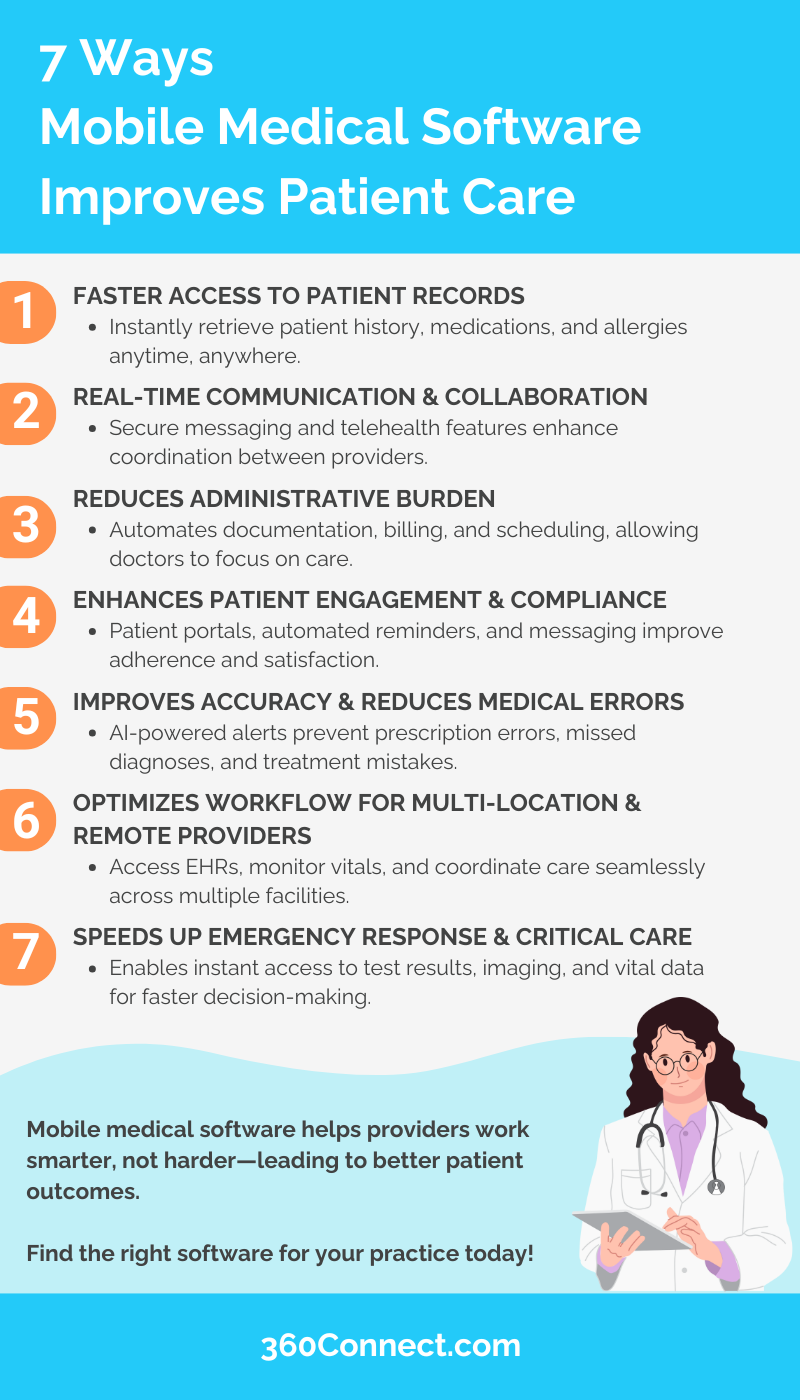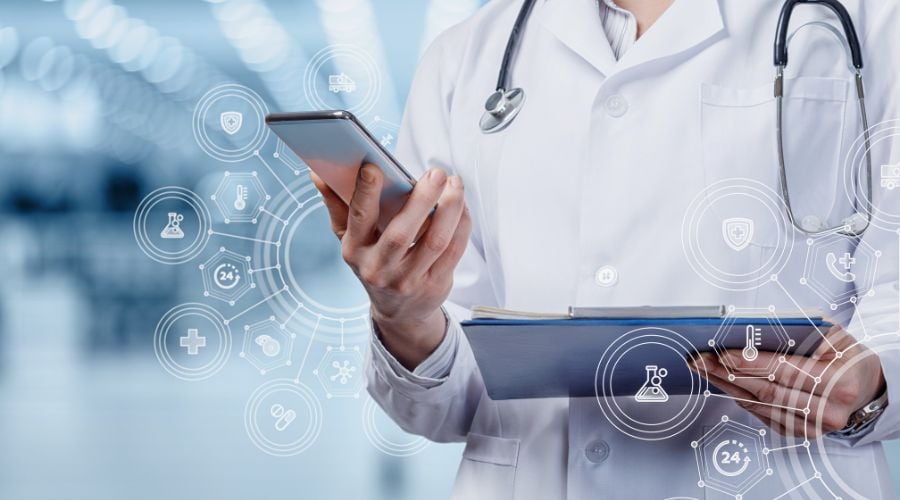The healthcare industry is evolving rapidly, and with it, the technology that supports patient care. One of the most transformative advancements in recent years is mobile medical software. With the ability to streamline workflows, improve accuracy, and enhance patient engagement, these tools have become essential for modern healthcare professionals.
But how exactly does mobile medical software improve patient care? If you’re a physician, nurse, or administrator looking for ways to optimize efficiency while delivering high-quality care, this guide is for you.

1. Faster Access to Patient Records
Gone are the days of flipping through thick paper charts or waiting to log into a desktop system. With mobile medical software, patient information is at your fingertips—whether you’re making rounds, seeing patients in multiple locations, or handling after-hours emergencies.
Why It Matters:
- Instant access to medical history, medications, and allergies before making treatment decisions.
- Improves patient safety by reducing the risk of prescribing medications with contraindications.
- Enhances coordination with specialists and referring physicians. For example, if you’re working in an urgent care facility and a patient arrives with severe asthma, being able to quickly pull up past treatment records can make a life-saving difference.
Real-World Scenario:
Imagine you’re a primary care physician, and one of your patients is rushed to the ER while you’re off-site. With mobile medical software, you can quickly access their records, share critical insights with the ER team, and ensure seamless care, all from your smartphone or tablet.
2. Real-Time Communication & Collaboration
Timely communication is essential in healthcare, yet many doctors still rely on outdated systems like pagers, faxes, or phone calls. Mobile medical software eliminates inefficiencies by offering secure messaging and telehealth capabilities.
Why It Matters:
- HIPAA-compliant messaging allows seamless communication between doctors, nurses, and specialists.
- Instant updates on test results and imaging so you can act faster.
- Telemedicine features enable virtual visits, reducing unnecessary in-person appointments.
Real-World Scenario:
A cardiologist consulting on a stroke patient’s CT scan doesn’t have to be in the hospital to review the images. With mobile medical software, they can analyze the scan, provide recommendations, and help initiate treatment immediately.
3. Reducing Administrative Burden
Let’s be honest—no doctor became a physician just to spend hours charting and handling paperwork. Administrative tasks take up too much time, cutting into patient interaction and increasing burnout. Mobile medical software automates and simplifies many of these tasks, allowing you to focus more on patient care.
Why It Matters:
- Speech-to-text dictation speeds up charting and reduces typing time.
- Automated billing and coding improve accuracy and reduce claim denials.
- Integration with practice management software for faster scheduling and referrals.
Real-World Scenario:
A doctor finishing up with a patient can dictate notes directly into the mobile EHR, and the system automatically suggests billing codes, ensuring timely and error-free claims submission.
4. Enhancing Patient Engagement & Compliance
Patients who actively participate in their own care tend to have better health outcomes. Mobile medical software allows patients to stay engaged through secure portals, automated reminders, and easy access to health data.
Why It Matters:
- Patients can schedule appointments, refill prescriptions, and access test results online.
- Automated reminders ensure patients don’t miss important medications or follow-ups.
- Two-way messaging lets patients ask quick questions without needing a full appointment.
Real-World Scenario:
A diabetic patient receives automated reminders to check blood sugar levels and take medications. If they forget, the system alerts their healthcare provider, enabling early intervention.
5. Improving Accuracy & Reducing Medical Errors
Medical errors are a serious issue, but mobile medical software helps reduce mistakes and improve decision-making by offering built-in safety features.
Why It Matters:
- Medication error prevention with real-time drug interaction alerts.
- Clinical decision support tools provide evidence-based treatment recommendations.
- E-prescribing capabilities minimize handwriting errors and prevent prescription fraud.
Real-World Scenario:
A physician prescribing a new antibiotic for a patient sees a pop-up alert warning of a potential drug interaction with the patient’s existing medication. This prevents adverse effects and improves patient safety.
6. Optimizing Workflow for Multi-Location & Remote Healthcare Providers
For doctors who practice in multiple locations, mobile medical software ensures seamless access to records and updates across all sites.
Why It Matters:
- Remote access to EHRs ensures consistency in patient care across different locations.
- Integration with wearables and remote monitoring tools for real-time vitals tracking.
- Easier referrals and specialist consultations for better continuity of care.
Real-World Scenario:
A physician seeing patients at both a clinic and a hospital can check records without logging into separate systems, ensuring consistent and informed treatment plans.
7. Speeding Up Emergency Response & Critical Care
In emergency situations, delays can cost lives. Mobile medical software reduces delays by providing instant access to critical patient data.
Why It Matters:
- Paramedics can upload real-time vitals and patient status to ER teams before arrival.
- Doctors can access imaging, EKGs, and lab results instantly.
- Faster decision-making for trauma, cardiac arrest, and critical cases.
Real-World Scenario:
A stroke patient arrives at the ER, and the neurologist can review the brain scan remotely before they even reach the hospital. This allows faster treatment, reducing long-term damage.
Exploring Mobile Medical Software Options
With the growing reliance on technology in healthcare, different types of mobile medical software have emerged to address a variety of needs. Some solutions focus on comprehensive patient record management, while others streamline administrative tasks or enhance communication between providers and patients.
Below, we break down the key categories, solutions, apps, and platforms of mobile medical software and how they contribute to improving patient care.
Common Mobile Medical Software Types
Mobile medical software encompasses various categories, each designed to improve different aspects of patient care and healthcare management. Here are the most common types:
1. Electronic Medical Records (EMR)
- A digital version of patient charts used within a single practice or organization.
- Helps track patient history, diagnoses, and treatments, but does not always integrate with other healthcare facilities.
- Best for small clinics and private practices that don’t need external data sharing.
- Related: What is EMR?
2. Electronic Health Records (EHR)
- Centralized digital patient records accessible across different healthcare settings.
- Enhances interoperability and streamlines patient data management.
- Stat: Approximately 88% of U.S. physicians use centralized EHR systems to analyze trends and improve care.
- Related: EHR: Features, Benefits, and Cost
3. Practice Management Software
- Handles administrative tasks like scheduling, billing, and patient communications.
- Reduces paperwork and improves office efficiency.
- Related: Practice Management Medical Software: Pros and Cons
4. Telemedicine Software
- Facilitates remote consultations between doctors and patients.
- Helps expand access to healthcare, especially in rural areas.
5. Medical Billing Software
- Automates claims processing and revenue cycle management.
- Ensures accurate coding and faster reimbursements.
Related: What is the Most Commonly Used Medical Software?
Common Mobile Medical Software Solutions
These are comprehensive, mobile-friendly medical software systems that include EHR, practice management, and billing capabilities.
- Epic Haiku & Canto – Mobile versions of Epic’s EHR, offering secure access to patient records, orders, and documentation.
- AthenaHealth – A cloud-based platform with mobile EHR, revenue cycle management, and patient engagement tools.
- DrChrono – A mobile-first EHR that integrates telemedicine, billing, and patient management.
- CureMD – A web-based EHR and practice management software with a strong mobile interface.
Supplementary Mobile Medical Apps & Platforms
These are specialized apps that enhance healthcare workflows but don’t serve as full-scale EHR or practice management solutions.
- Doctor on Demand – A telemedicine platform connecting patients with doctors for virtual consultations.
- Talkspace – A mobile therapy app offering secure, virtual mental health counseling.
- Doximity – A professional network for doctors with secure messaging, video calls, and digital faxing.
- MyChart – A patient portal allowing users to access health records, schedule appointments, and communicate with doctors.
- Epocrates – A clinical reference app for drug interactions, dosing guidelines, and disease reference tools.
Final Thoughts
The future of healthcare is mobile. Whether you’re a solo practitioner, hospital physician, or specialist, adopting mobile medical software can enhance efficiency, improve patient outcomes, and reduce stress.
By enabling instant access to patient records, real-time collaboration, and automated administrative tasks, mobile medical software lets you focus on what truly matters—delivering quality care.
Get Matched with the Right Medical Software
Looking for the best mobile medical software for your practice? At 360Connect, we connect healthcare providers with top-rated medical software solutions tailored to their needs.
Tell us what you need, and we’ll match you with up to 5 providers—fast and hassle-free.

